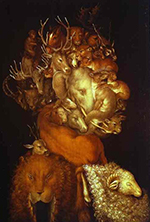What Causes Optical Illusions?
Submitted by
CharlieGrade level
10Answered by
Abigail Howell, Undergraduate student, Biomedical Sciences
An optical illusion occurs when you the way you see something is different from what the object really is. Optical illusions occur when there is an error in how the brain interprets what the eyes are seeing. In general, there are 3 types of optical illusions.
Literal Optical Illusions

Literal optical illusions are often produced by putting together a collection of multiple images. Each individual image may be easy to see, but the images together may look very different than the originals. This is accomplished through what is known as the “filling-in phenomena.” When the eye sends visual information to the brain, the brain chooses what parts to focus on. Depending on the focus, different layers of the image may be seen.
In the optical illusion "Earth" by Giuseppe Arcimboldo, you may see two very different images. If you focus on the whole image you may see a man’s face. But if you focus on the smaller details of the image you may start to see that there are images of many different animals.
Physiological Illusions

Physiological illusions cause a person to see parts of an image that are not actually there. These images often have multiple copies of the same image or pattern. The repeating pattern of the image will activate the same pathways of the visual system no matter where the eyes focus. This overloads the visual system, creating the optical illusion.
An example of this is the Herman Grid Illusion. The image is made of only black boxes and white lines, but when looking at it, you will likely see faint black dots where the white lines cross. This illusion takes advantage of the visual system process information for contrasting colors.
Cognitive Illusions

Cognitive illusions use a person’s assumptions about the world to create optical illusions. These illusions do not rely on any kind of biological mechanism. Rather, they defy a person’s traditional thinking, creating an image that seems to break the rules that we've learned for physical items. This can be seen in Oscar Reutersvärd’s Penrose Triangle. If you try to follow one side of this shape, it leads you to all other sides of the shape, making it seem to be incapable of defining or following.
Grey square optical illusion image by Edward H. Adelson
Bibliographic details:
- Article: What Causes Optical Illusions?
- Author(s): Abigail Howell
- Publisher: Arizona State University School of Life Sciences Ask A Biologist
- Site name: ASU - Ask A Biologist
- Date published:
- Date accessed:
- Link: https://askabiologist.asu.edu/questions/what-causes-optical-illusions
APA Style
Abigail Howell. (). What Causes Optical Illusions?. ASU - Ask A Biologist. Retrieved from https://askabiologist.asu.edu/questions/what-causes-optical-illusions
Chicago Manual of Style
Abigail Howell. "What Causes Optical Illusions?". ASU - Ask A Biologist. . https://askabiologist.asu.edu/questions/what-causes-optical-illusions
Abigail Howell. "What Causes Optical Illusions?". ASU - Ask A Biologist. . ASU - Ask A Biologist, Web. https://askabiologist.asu.edu/questions/what-causes-optical-illusions
MLA 2017 Style

Optical illusions cause us to see things in unique ways.
Be Part of
Ask A Biologist
By volunteering, or simply sending us feedback on the site. Scientists, teachers, writers, illustrators, and translators are all important to the program. If you are interested in helping with the website we have a Volunteers page to get the process started.
